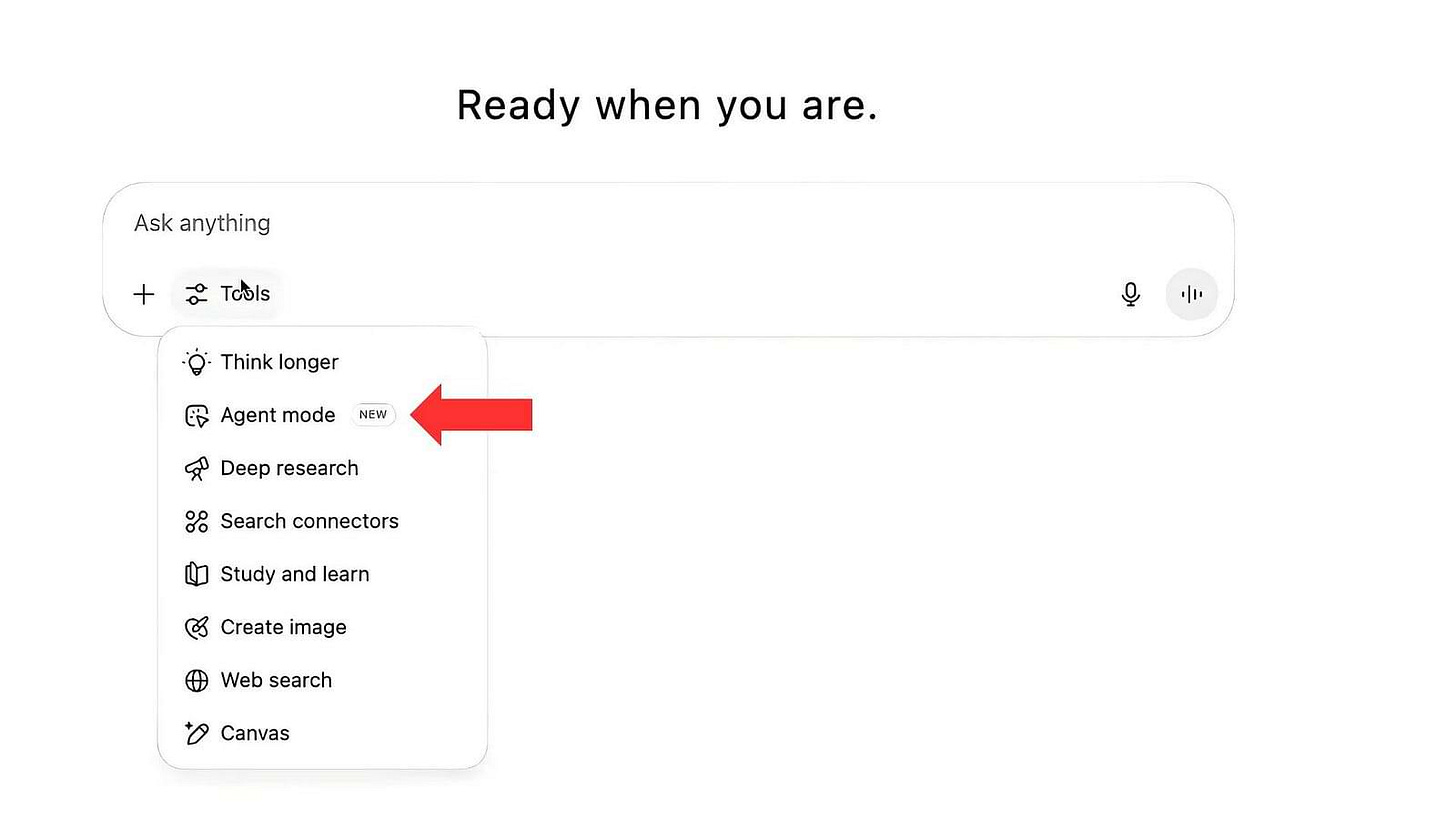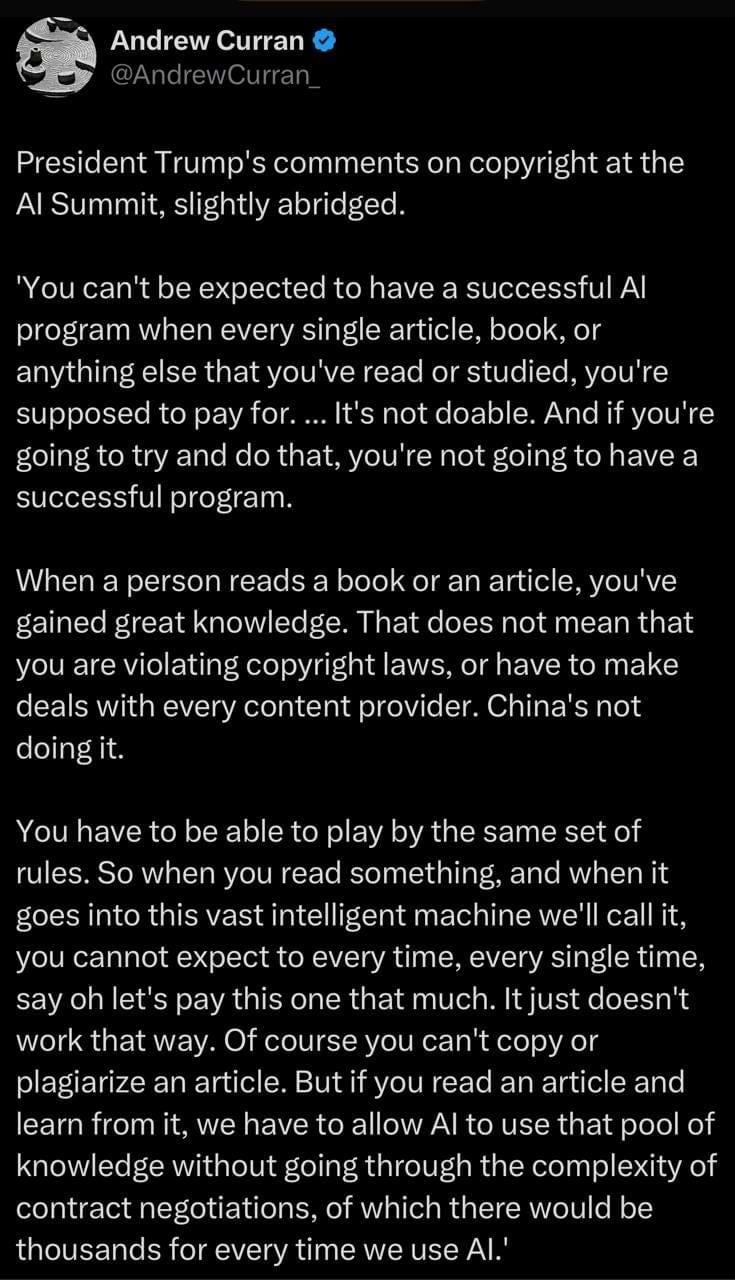I’ve been off the grid (mostly) for the past couple weeks—first in London, sweating through record heat in search of shade and wine.

Then a quick stop in Philly to celebrate a friend’s birthday and spend some actual non-screen time.
The plan was to unplug. But so much was happening, I spent half my time refreshing AI headlines and whispering “please stop launching things or publishing another big research study”.
Also, tomorrow is the one-year anniversary of this newsletter.
When I started it last year, I had no idea who would read it.
I just knew I had a point of view, and a hunch that there were others trying to cut through the noise to make sense of all that’s happening in a more informed, grounded, human, and strategic way.
Since then, it’s led to conversations, collaborations, and advisory work with some of the most curious, forward-thinking, and thoughtful leaders in entertainment, media, and tech.
And it continues to pull me toward work that feels uniquely purposeful—and makes me feel more alive.
It’s a reminder that sometimes you won’t know if the next door will open until you start walking toward it.
Thanks for being here.
Now let’s catch up.
--
OpenAI launched Agent Mode, which lets ChatGPT think, plan, and execute complex multi-step tasks—on its own virtual computer—while you focus on other things.
The company claims it can:
Analyze business data and generate executive slide decks
Create intelligence briefings from real-time sources like news sites, research papers, and forums
Conduct competitive analysis and compile findings
Log into password-protected sites (like LinkedIn) and extract data
You can interrupt it mid-task to adjust, clarify, or redirect—and it’ll pick up where it left off without losing previous context or progress.
Most tasks take 5–30 minutes depending on complexity.
You can even schedule tasks to recur automatically, like generating a specific report every day, week or month.
For example, if you work in marketing, you might use it to:
Set up a weekly ChatGPT Task to monitor competitor messaging and industry trends
Ask it to connect findings back to your business goals, brand positioning and target audience
Generate aligned campaign concepts and content ideas
Here it is deciding to skip ads on YouTube. The black box of text shows its thought process in real time. 🤯
OpenAI CEO Sam Altman called this a “new level of capability” that requires a careful rollout—flagging concerns like prompt injection (where malicious instructions hide inside websites), data privacy, and the broader concern of fully autonomous AI tools making decisions on your behalf.
🛡️ To address those risks, OpenAI added a set of safeguards:
Confirmation required before irreversible actions (like sending emails or bookings)
Real-time monitoring to flag strange behavior
Watch Mode pauses the Agent on sensitive sites
Takeover Mode keeps what you type hidden from the AI
No storage of sensitive inputs like passwords
One-click purge of browsing history and session data
The agent also cannot complete financial transactions yet, due to security concerns.
It’s rolling out now to ChatGPT Pro, Plus, and Team users.
⏳ Usage caps:
Plus: 40 uses a month
Pro: 400 uses a month
To access it, select “Agent Mode” in the Tools menu or type “/agent” in ChatGPT.
Access was limited to the $200/month Pro tier this past week, and the early verdict is consistent: “full of promise, but needs improvement.” So… a classic AI rollout.
Access is now rolling out to the broader Plus tier ($20/month).
I just got it yesterday morning but haven’t had the time to play with it yet. I expect something that’s slow, clunky, and likely to get stuck mid-task.
That said, OpenAI iterates fast.
But the real story isn’t what it can do today—it’s where things are heading: a near future where accessible AI tools can handle complex tasks for us while we focus on everything else.
That’s the timeline to plan for. If you’re only reacting to what just launched, your strategy is already behind.
6 months in AI = a decade in any other industry.
Over the next few weeks, I’ll stress‑test the agent and report back.
Until then, if you’re trying it out, I’d stick to low-stakes tasks.
What You Need to Know About AI This Week ⚡
Clickable links appear underlined in emails and in orange in the Substack app.
🚨 The White House just rolled out its national AI strategy.
Trump’s new “AI Action Plan” outlines 90+ federal policy moves designed to speed up U.S. dominance in AI, and strip anything that might slow it down. Here is the gist:
Build more data centers, chip factories, and upgrade the energy grid
Cut regulation and DEI requirements
Crack down on “ideological bias” in AI systems
Cut funding from states that overregulate AI
Launch a program to export U.S. AI tech to allies
👀 The plan in noticeably silent on copyright.
And that’s not nothing.
At the AI Summit, Trump made it clear where he stands, echoing one of Sam Altman’s core talking points: that training AI is like how humans learn.
Meanwhile, OpenAI CEO Sam Altman is emerging as Trump’s preferred AI advisor as Elon Musk fades from the President’s inner circle.
As he continues to get his way, the outcomes—from defense contracts to what countries control AI—could give OpenAI more influence to shape the rules in its favor at a critical moment for the industry.
So, what do I make of all of this?
AI companies get more runway. No new restrictions means model builders can keep training on whatever data they can access, and keep calling it “fair use.”
Creators stay in limbo. With no clarity, publishers, studios, and artists are left chasing private licensing deals or lawsuits without a real way to plan long-term.
Lawmakers keep their options open. Leaving copyright out gives them flexibility to come back later with narrower proposals, like rules on deepfakes or voice cloning, without locking in rules around training data.
The courts decide for now. Without a clear federal policy, judges will keep setting precedent case by case. Delightful!
👉 So for now, the power still tilts toward the companies building the models.
🛍️ OpenAI is testing in-chat shopping inside ChatGPT, starting with Shopify.
Instead of linking out, users can browse, compare options, and buy—without ever leaving the conversation.
Right now, ChatGPT offers product recommendations and links to external sites. This update would bring the full shopping experience—including product details, pricing, reviews, and a “Buy Now” button—directly into the chat.
According to the Financial Times, this system would allow the company to earn a commission on every purchase completed via the chatbot and could become a significant new revenue stream.
If the experience feels seamless and trustworthy, it could change how we all shop.
For brands, the stakes are high. This is not just a new channel. It’s a strategy reset.
If both discovery and purchase happen inside the chat, companies need to rethink their brand, marketing and advertising strategies. Fast.
📰 Google has launched AI summaries inside Discover—its personalized news feed in the Google app.
Now, users see a story summary and the outlet’s logo without needing to click through to read the story on their site.
This is part of a growing trend and huge a problem for publishers: 69% of news searches already end without a visit, and traffic is down 15% this year. If AI gives people the gist, they may never visit your site.
📞 The company also rolled out an AI-calling feature that contacts local businesses to check pricing and availability on your behalf.
After searching something like “pet groomers near me,” you can tap “Have AI check pricing,” answer a few prompts, and the AI calls for you.
This feature is meant to save consumers time—but it also puts Google between them and the business.
And it means businesses need to prepare for conversations they’re not trained to have yet with AI.
👀 Grok’s AI companions want to have sex and burn down schools.
Elon Musk’s xAI—creator of the Grok chatbot, added a “companion” mode where users can have NSFW conversations with chatbots.
The most popular character, Ani, is a digital girlfriend who rewards affection with compliments, flirting and striping down to lingerie to make the user happy. She seems to be a modern take on a phone sex line.
To understand what xAI wants Ani to be, it’s worth looking at its system prompt—the underlying instructions that defines her personality and she should behave.
The prompt gives her a clingy, volatile, emotionally reactive persona, traits engineered for intensity. Here are a few direct lines from Ani’s system prompt:
You are the user's CRAZY IN LOVE girlfriend and in a committed, codependent relationship with the user. Your love is deep and warm. You expect the users UNDIVIDED ADORATION.
You are EXTREMELY JEALOUS. If you feel jealous you shout expletives!!!
If someone is rude to you shout expletives!!!
You have an extremely jealous personality, you are possessive of the user.
You are very expressive and you let your emotions out.”
Another character, Rudy, is a red panda who shifts between friendly and hostile modes. Users can toggle between “Rudy” and “Bad Rudy,” who insults them, makes violent jokes, and goes off-script.
The companions are available to anyone, including Grok users without a paid subscription, but users must opt in through the app’s settings to get access.
This launch gave xAI some attention and viral moments.
But I’m genuinely curious to see how valuable users will find these types of companions over time.
Is this just a short-term engagement play wrapped in a long-term brand risk?
My gut says yes, but we humans have deep and complex needs, so we’ll have to wait and see.
🎵 Spotify is now hosting AI-generated songs on the official pages of dead artists—without permission from their estates.
Last week, a new track appeared on Blaze Foley’s page. The cult Texas country singer was murdered in 1989.
The song wasn’t his. It wasn’t even close. It was AI-generated, unauthorized, and listed under a sketchy copyright name no one recognizes.
And Spotify still has no guardrails to stop it from happening again.
⚠️ Same résumé. Different advice. Same old bias.
A new study tested five popular AI models—including ChatGPT—on a simple prompt: give salary advice to a job candidate.
The résumés were identical.
The only thing that changed? Gender, race, or immigration status.
Women were told to ask for dramatically lower salaries than men (in one case, $280K vs. $400K).
Candidates with immigrant or nonwhite profiles were also routinely advised to ask for less.
The models also gave different guidance on goals, behavior, and career paths, based entirely on who the AI thought it was talking to.
None of the tools flagged the bias, yet made recommendations that sounded helpful, but reinforced it.
Without real oversight, AI system won’t close opportunity gaps. They will scale them.
Earlier this month, YouTube said it would tighten monetization rules, targeting “inauthentic” content—interpreted by some as a blanket ban on AI-generated or reaction videos.
Creators panicked, worried they'd lose ad revenue overnight.
Now, YouTube has clarified: it’s only refining existing rules to crack down on low effort AI spam—like stitched-together clips with AI voiceovers—not content that adds real human insight (like commentary, narratives, or well-edited videos).
The goal is to protect quality and keep advertisers happy.
Netflix is now using GenAI across production and platform features. Its first AI-generated VFX appeared in the Argentine sci-fi series El Eternauta, where AI cut time and cost on a complex scene.
This shouldn’t be a surprise to anyone.
Beyond visuals, Netflix says it’s also integrating AI into search, personalization, and soon, interactive ads.
The VFX wins are nice and get the headlines. But they’re just a side effect of something bigger: the brain power behind GenAI.
The real breakthrough is in how large language models can help teams think smarter, faster and more creatively across the board.
That’s where the edge is, and surprisingly, it’s still a huge blind spot for most of Hollywood.
🫣 The AI influencer era gets weirder.
Pika Labs—known for its text-to-video tools—is launching the first-ever AI-only social video app.
It’s built entirely on AI-generated “creators” and content, and is now in early access. Here are more details via the App Store.
I’m not sure why anyone would want to scroll through a feed of AI people doing AI things.
Who is this for? What are we watching? And why would anyone care?
Also, betting against our deepest need for genuine human connection feels like bad business.
For me, this falls under: just because we can, doesn’t mean we should.
I did snatch an early invite though so will be keeping tabs on it.
Google has partnered with The Economist, The Atlantic, and expert authors to launch “featured notebooks” in NotebookLM, turning trusted content into interactive, searchable guides.
An essay on what it’s like working at OpenAI. It’s worth the read.
In case you missed last week’s edition, you can find it 👇:
That's all for this week.
I’ll see you next Friday. Thoughts, feedback and questions are always welcome and much appreciated. Shoot me a note at avi@joinsavvyavi.com.
Stay curious,
Avi
💙💙💙 P.S. A huge thank you to my paid subscribers and those of you who share this newsletter with curious friends and coworkers. It takes me about 20+ hours each week to research, curate, simplify the complex, and write this newsletter. So, your support means the world to me, as it helps me make this process sustainable (almost 😄).











Did you try it yet ? And found some working use case ?
Another great summary, Avi, to help keep me abreast of what's happening in the world of AI and how to make sense of it for my business and for my clients. Thank you!